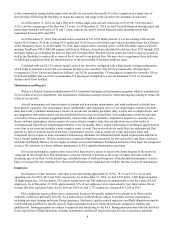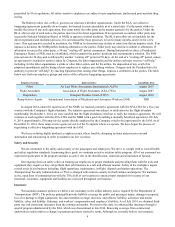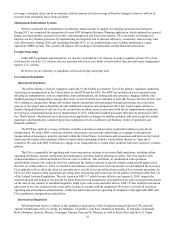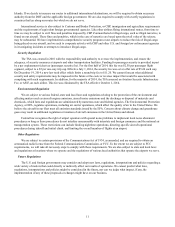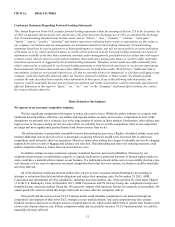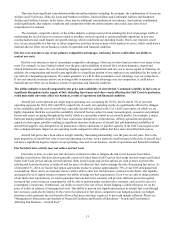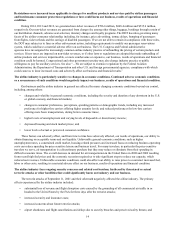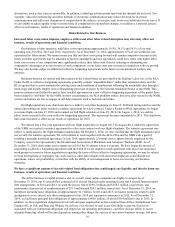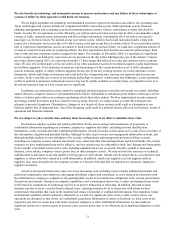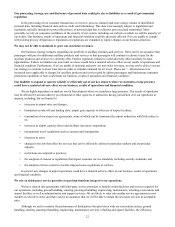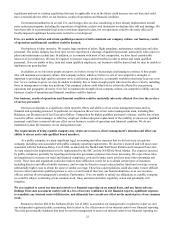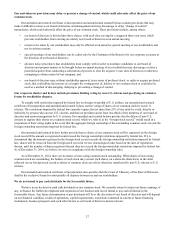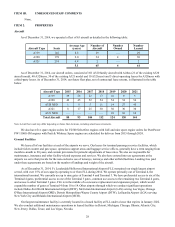Spirit Airlines 2014 Annual Report Download - page 18
Download and view the complete annual report
Please find page 18 of the 2014 Spirit Airlines annual report below. You can navigate through the pages in the report by either clicking on the pages listed below, or by using the keyword search tool below to find specific information within the annual report.18
capital. Factors that affect our ability to raise financing or access the capital markets include market conditions in the airline
industry, economic conditions, the perceived residual value of aircraft and related assets, the level and volatility of our earnings,
our relative competitive position in the markets in which we operate, our ability to retain key personnel, our operating cash
flows and legal and regulatory developments. Regardless of our creditworthiness, at times the market for aircraft purchase or
lease financing has been very constrained due to such factors as the general state of the capital markets and the financial
position of the major providers of commercial aircraft financing.
Our liquidity and general level of capital resources impact our ability to hedge our fuel requirements.
We enter into fuel derivative contracts in order to mitigate the risk to our business from future volatility in fuel prices,
refining risk between the price of crude oil and the price of refined jet fuel, and to manage the risk of increasing fuel prices. As
of December 31, 2014, we had jet fuel option agreements in place to protect approximately 35% of our 2015 anticipated fuel
consumption. There can be no assurance that we will be able to enter into fuel derivative contracts in the future. In the past, we
have not had and in the future we may not have sufficient creditworthiness or liquidity to post the collateral necessary to hedge
our fuel requirements. Even if we are able to hedge portions of our future fuel requirements, we cannot guarantee that our
derivative contracts will provide any particular level of protection against increased fuel costs or that our counterparties will be
able to perform under our derivative contracts, such as in the case of a counterparty’s insolvency. In a falling fuel environment,
we may be forced to make cash payments to the counterparties which may impair our liquidity position and increase our costs.
Furthermore, our ability to react to the cost of fuel, absent hedging, is limited, because we set the price of tickets in advance of
knowing our fuel costs at the time the tickets are flown. Our ability to pass on any significant increases in aircraft fuel costs
through fare increases could also be limited.
We rely on maintaining a high daily aircraft utilization rate to implement our low cost structure, which makes us
especially vulnerable to flight delays or cancellations or aircraft unavailability.
We maintain a high daily aircraft utilization rate. Our average daily aircraft utilization was 12.7 hours, 12.7 hours and
12.8 hours for 2014, 2013 and 2012, respectively. Aircraft utilization is the average amount of time per day that our aircraft
spend carrying passengers. Our revenue per aircraft can be increased by high daily aircraft utilization, which is achieved in part
by reducing turnaround times at airports so we can fly more hours on average in a day. Aircraft utilization is reduced by delays
and cancellations from various factors, many of which are beyond our control, including air traffic congestion at airports or
other air traffic control problems, adverse weather conditions, increased security measures or breaches in security, international
or domestic conflicts, terrorist activity, or other changes in business conditions. A significant portion of our operations are
concentrated in markets such as South Florida, the Caribbean, Latin America and the Northeast and northern Midwest regions
of the United States, which are particularly vulnerable to weather, airport traffic constraints and other delays. In addition,
pulling aircraft out of service for unscheduled and scheduled maintenance, the occurrence of which will increase as our fleet
ages, may materially reduce our average fleet utilization and require that we seek short-term substitute capacity at increased
costs. Due to the relatively small size of our fleet and high daily aircraft utilization rate, the unavailability of one or more
aircraft and resulting reduced capacity could have a material adverse effect on our business, results of operations and financial
condition.
Our maintenance costs will increase as our fleet ages, and we will periodically incur substantial maintenance costs due
to the maintenance schedules of our aircraft fleet.
As of December 31, 2014, the average age of our aircraft was approximately 5.1 years. Our relatively new aircraft require
less maintenance now than they will in the future. Our fleet will require more maintenance as it ages and our maintenance and
repair expenses for each of our aircraft will be incurred at approximately the same intervals. We expect that the final heavy
maintenance events will be amortized over the remaining lease term rather than until the next estimated heavy maintenance
event, because we account for heavy maintenance under the deferral method. This will result in significantly higher
depreciation and amortization expense related to heavy maintenance in the last few years of the leases as compared to the costs
in earlier periods. Moreover, because our current fleet was acquired over a relatively short period, significant maintenance that
is scheduled on each of these planes is occurring at roughly the same time, meaning we will incur our most expensive
scheduled maintenance obligations, known as heavy maintenance, across our present fleet around the same time. These more
significant maintenance activities result in out-of-service periods during which our aircraft are dedicated to maintenance
activities and unavailable to fly revenue service. In addition, the terms of some of our lease agreements require us to pay
supplemental rent, also known as maintenance reserves, to the lessor in advance of the performance of major maintenance,
resulting in our recording significant prepaid deposits on our balance sheet. We expect scheduled and unscheduled aircraft
maintenance expenses to increase as a percentage of our revenue over the next several years. Any significant increase in
maintenance and repair expenses would have a material adverse effect on our business, results of operations and financial
condition. Please see “Management’s Discussion and Analysis of Financial Condition and Results of Operations—Critical


